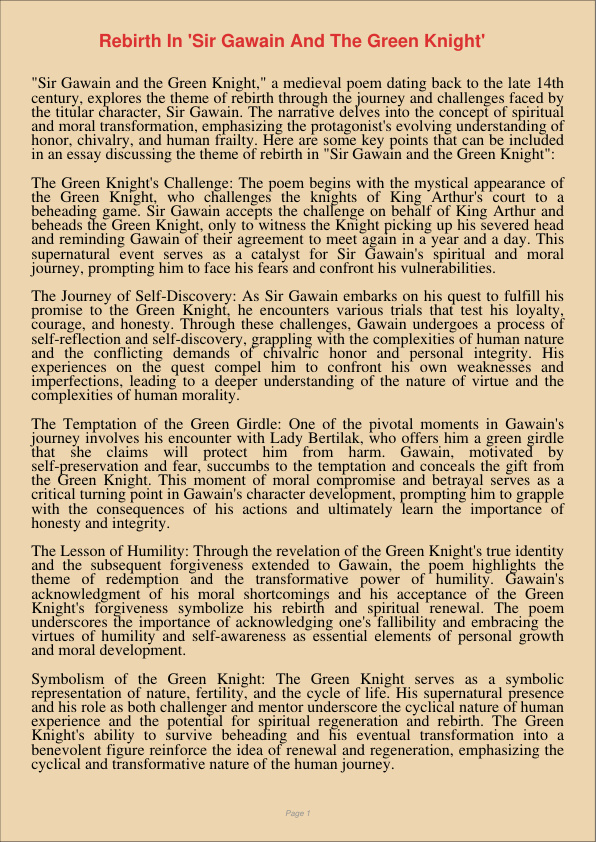Rebirth In Sir Gawain And The Green Knight
Dec 31, 2023
sir gawain
green knight
Business
Journalism & Communication
“Sir Gawain and the Green Knight,” a medieval poem dating back to the late 14th century, explores the theme of rebirth through the journey and challenges faced by the titular character, Sir Gawain. The narrative delves into the concept of spiritual and moral transformation, emphasizing the protagonist’s evolving understanding of honor, chivalry, and human frailty. Here are some key points that can be included in an essay discussing the theme of rebirth in “Sir Gawain and the Green Knight”:
The Green Knight’s Challenge: The poem begins with the mystical appearance of the Green Knight, who challenges the knights of King Arthur’s court to a beheading game. Sir Gawain accepts the challenge on behalf of King Arthur and beheads the Green Knight, only to witness the Knight picking up his severed head and reminding Gawain of their agreement to meet again in a year and a day. This supernatural event serves as a catalyst for Sir Gawain’s spiritual and moral journey, prompting him to face his fears and confront his vulnerabilities.
The Journey of Self-Discovery: As Sir Gawain embarks on his quest to fulfill his promise to the Green Knight, he encounters various trials that test his loyalty, courage, and honesty. Through these challenges, Gawain undergoes a process of self-reflection and self-discovery, grappling with the complexities of human nature and the conflicting demands of chivalric honor and personal integrity. His experiences on the quest compel him to confront his own weaknesses and imperfections, leading to a deeper understanding of the nature of virtue and the complexities of human morality.
The Temptation of the Green Girdle: One of the pivotal moments in Gawain’s journey involves his encounter with Lady Bertilak, who offers him a green girdle that she claims will protect him from harm. Gawain, motivated by self-preservation and fear, succumbs to the temptation and conceals the gift from the Green Knight. This moment of moral compromise and betrayal serves as a critical turning point in Gawain’s character development, prompting him to grapple with the consequences of his actions and ultimately learn the importance of honesty and integrity.
The Lesson of Humility: Through the revelation of the Green Knight’s true identity and the subsequent forgiveness extended to Gawain, the poem highlights the theme of redemption and the transformative power of humility. Gawain’s acknowledgment of his moral shortcomings and his acceptance of the Green Knight’s forgiveness symbolize his rebirth and spiritual renewal. The poem underscores the importance of acknowledging one’s fallibility and embracing the virtues of humility and self-awareness as essential elements of personal growth and moral development.
Symbolism of the Green Knight: The Green Knight serves as a symbolic representation of nature, fertility, and the cycle of life. His supernatural presence and his role as both challenger and mentor underscore the cyclical nature of human experience and the potential for spiritual regeneration and rebirth. The Green Knight’s ability to survive beheading and his eventual transformation into a benevolent figure reinforce the idea of renewal and regeneration, emphasizing the cyclical and transformative nature of the human journey.
In conclusion, “Sir Gawain and the Green Knight” portrays the theme of rebirth as a transformative process that involves moral and spiritual growth, the recognition of human frailty, and the pursuit of personal integrity. The poem emphasizes the importance of self-reflection, humility, and moral accountability as essential elements of the quest for spiritual renewal and ethical transformation. Sir Gawain’s journey serves as an allegory for the complexities of human morality and the enduring pursuit of personal and spiritual redemption.
